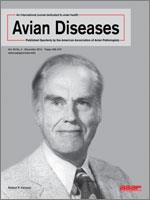Single swabs (cultured individually) are currently used in the Food and Drug Administration (FDA) official method for sampling the environment of commercial laying hens for the detection of Salmonella enterica ssp. serovar Enteritidis (Salmonella Enteritidis). The FDA has also granted provisional acceptance of the National Poultry Improvement Plan’s (NPIP) Salmonella isolation and identification methodology for samples taken from table-egg layer flock environments. The NPIP method, as with the FDA method, requires single-swab culturing for the environmental sampling of laying houses for Salmonella Enteritidis. The FDA culture protocol requires a multistep culture enrichment broth, and it is more labor intensive than the NPIP culture protocol, which requires a single enrichment broth. The main objective of this study was to compare the FDA single-swab culturing protocol with that of the NPIP culturing protocol but using a four-swab pool scheme. Single and multilaboratory testing of replicate manure drag swab sets (n = 525 and 672, respectively) collected from a Salmonella Enteritidis–free commercial poultry flock was performed by artificially contaminating swabs with either Salmonella Enteritidis phage type 4, 8, or 13a at one of two inoculation levels: low, x¯ = 2.5 CFU (range 2.5–2.7), or medium, x¯ = 10.0 CFU (range 7.5–12). For each replicate, a single swab (inoculated), sets of two swabs (one inoculated and one uninoculated), and sets of four swabs (one inoculated and three uninoculated), testing was conducted using the FDA or NPIP culture method. For swabs inoculated with phage type 8, the NPIP method was more efficient (P < 0.05) for all swab sets at both inoculation levels than the reference method. The single swabs in the NPIP method were significantly (P < 0.05) better than four-pool swabs in detecting Salmonella Enteritidis at the lower inoculation level. In the collaborative study (n = 13 labs) using Salmonella Enteritidis phage type 13a inoculated swabs, there was no significant difference (P > 0.05) between the FDA method (single swabs) and the pooled NPIP method (four-pool swabs). The study concludes that the pooled NPIP method is not significantly different from the FDA method for the detection of Salmonella Enteritidis in drag swabs in commercial poultry laying houses. Consequently based on the FDA’s Salmonella Enteritidis rule for equivalency of different methods, the pooled NPIP method should be considered equivalent. Furthermore, the pooled NPIP method was more efficient and cost effective.
How to translate text using browser tools
15 September 2015
Validation of Single and Pooled Manure Drag Swabs for the Detection of Salmonella Serovar Enteritidis in Commercial Poultry Houses
Hailu Kinde,
Helen A. Goodluck,
Maurice Pitesky,
Tom D. Friend,
James A. Campbell,
Ashley E. Hill
ACCESS THE FULL ARTICLE

Avian Diseases
Vol. 59 • No. 4
December 2015
Vol. 59 • No. 4
December 2015




